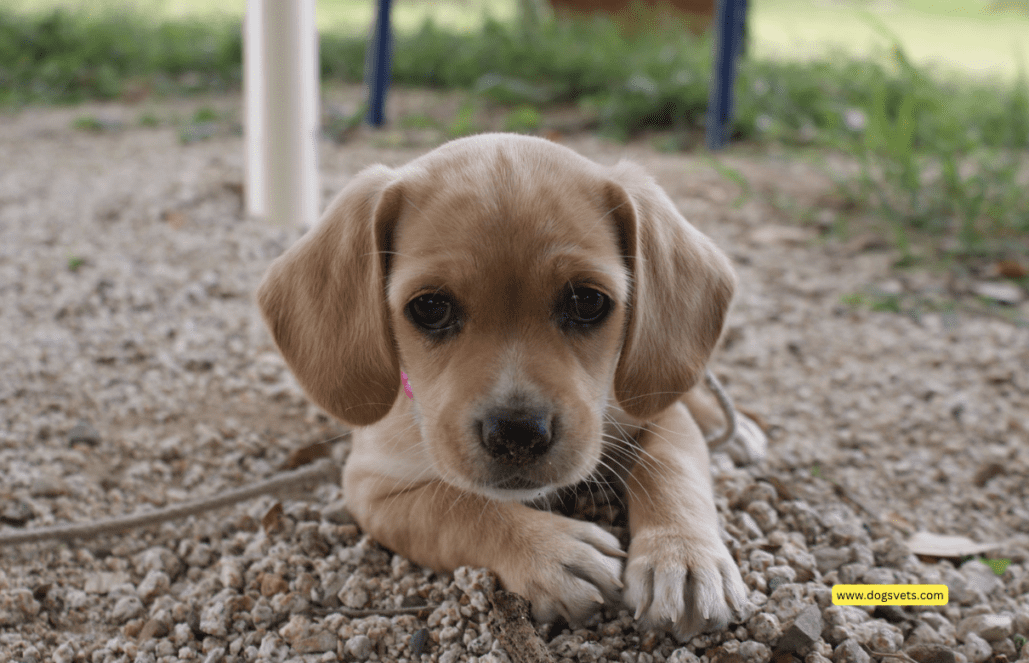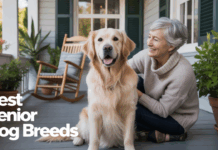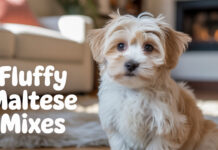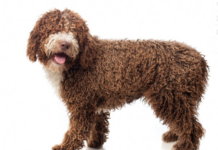Last Updated on January 4, 2024 by Dogs Vets
The Adorable and Energetic Cavador Dog
The Cavador, a charming cross between the Cavalier King Charles Spaniel and the Labrador Retriever, has become a popular choice for dog lovers seeking a friendly, playful, and intelligent companion.
But before you welcome this cuddly cutie into your home, let’s explore everything you need to know about the Cavador mix:
Origins and Appearance:

- A Blend of Breeds: The Cavador is a designer breed, resulting from the intentional crossing of a Cavalier King Charles Spaniel and a Labrador Retriever. Its appearance can vary, often inheriting traits from both parent breeds.
- Size and Build: Expect a medium-sized dog, usually weighing between 25 and 55 pounds. Cavadors typically stand 15-20 inches at the shoulder. Their build can be more stocky like a Lab or leaner like a Cavalier.
- Coat and Colors: Expect a double coat that’s medium-length and can be straight, wavy, or even slightly curly.Colors range from black, brown, and golden to a combination of these, often with white markings.
Temperament and Personality:
- A Blend of Traits: As a mix, the Cavador’s personality can inherit characteristics from both the Cavalier and Lab. From the Cavalier, expect sweetness, gentleness, and a love for cuddling. From the Lab, expect high energy, playfulness, and eagerness to please.
- Friendly and Devoted: Cavadors are typically friendly and outgoing with both humans and other dogs. They form strong bonds with their families and love spending time with them.
- Energetic and Playful: Expect a dog with a playful spirit and boundless energy. They’ll need regular exercise and playtime to stay happy and healthy.
- Gentle and Good with Children: Cavadors have a gentle nature and can be excellent companions for children,especially when raised and socialized properly.
Care and Training:
- Exercise Needs: These energetic pups need regular exercise, including walks, playtime, and mental stimulation.Aim for at least 60 minutes of activity per day.
- Trainability: Both parent breeds are intelligent and eager to please, making Cavadors fairly easy to train.Positive reinforcement methods are recommended.
- Grooming: Regular brushing helps maintain their double coat and prevent matting. Bathing frequency depends on their activity level, but usually once every 6-8 weeks is sufficient.
- Potential Health Concerns: Like any mixed breed, Cavadors can inherit health issues from both parent breeds. Hip dysplasia, ear infections, and eye problems are some potential concerns. Responsible breeders health-test their dogs to minimize these risks.
Is a Cavador Right for You?
Before welcoming a Cavador into your life, consider your lifestyle and preferences:
- Active Families: Cavadors thrive with active families who can provide them with plenty of exercise and playtime.
- Apartment Living: With proper training and outlets for their energy, Cavadors can adapt to apartment living,but a backyard is ideal.
- First-Time Dog Owners: While trainable, Cavadors can be energetic and require dedication. Experienced dog owners may be a better fit.
Final Thoughts:
The Cavador mix is a charming and lovable companion known for their playful spirit, gentle nature, and unwavering devotion. They can be excellent family dogs but require an active lifestyle and proper training.
If you’re looking for a furry friend who will fill your life with joy, cuddles, and endless games of fetch, a Cavador might be the perfect match for you.
Just remember, do your research, choose a responsible breeder, and be prepared to provide your pup with the love, care, and training they need to thrive.
5 Burning Questions About the Cavador Mix, Answered!
The Cavador, a captivating blend of the Cavalier King Charles Spaniel and Labrador Retriever, has swept hearts with its playful spirit and affectionate nature.
But before welcoming this cuddly charmer into your life, you might have some lingering questions. Let’s dive into 5 common questions about Cavadors:
1. Are Cavadors good family dogs?
Absolutely! Cavadors are known for their gentle nature, devotion to family, and love for children. Their playful spirit makes them fun companions for kids, but remember, proper socialization and supervision are always key.
2. Can Cavadors live in apartments?
While they inherit the Lab’s boundless energy, Cavadors can adapt to apartment living surprisingly well. With regular walks, playtime, and mental stimulation, they can thrive in smaller spaces. However, a backyard is always a bonus for their energetic bursts.
3. Do Cavadors require a lot of exercise?
Yes, Cavadors are energetic pups and need regular exercise to stay happy and healthy. Aim for at least 60 minutes of activity per day, including walks, playtime, and mental stimulation like fetch or training sessions.
4. Are Cavadors easy to train?
Both parent breeds are intelligent and eager to please, making Cavadors fairly easy to train. Positive reinforcement methods work best, and their playful nature makes learning fun for both you and your pup.
5. Are Cavadors prone to any health problems?
Like any mixed breed, Cavadors can inherit health concerns from both parent breeds. Hip dysplasia, ear infections, and eye problems are some potential issues. Responsible breeders health-test their dogs to minimize these risks.
Remember, adopting a Cavador from a shelter or rescue organization is a wonderful way to give a loving home to a deserving animal. Do your research, choose a responsible breeder, and prepare to shower your furry friend with love, care, and plenty of playtime!
These answers are just a starting point, and further research is always recommended.
Talk to breeders, veterinarians, and experienced Cavador owners to gain a deeper understanding of this delightful breed and determine if they’re the perfect fit for your lifestyle.
Additional Resources:
- The Cavadoodle Club: https://rockykanaka.com/cavapoo/
- Cavalier King Charles Spaniel Club: https://ckcsc.org/
- Labrador Retriever Club of America: https://thelabradorclub.com/event/lrc-national-specialty/
P.S. Remember, adopting a dog from a shelter or rescue organization is a wonderful way to give a loving home to a deserving animal. Consider checking if any Cavador mixes are available for adoption before purchasing from a breeder.

















